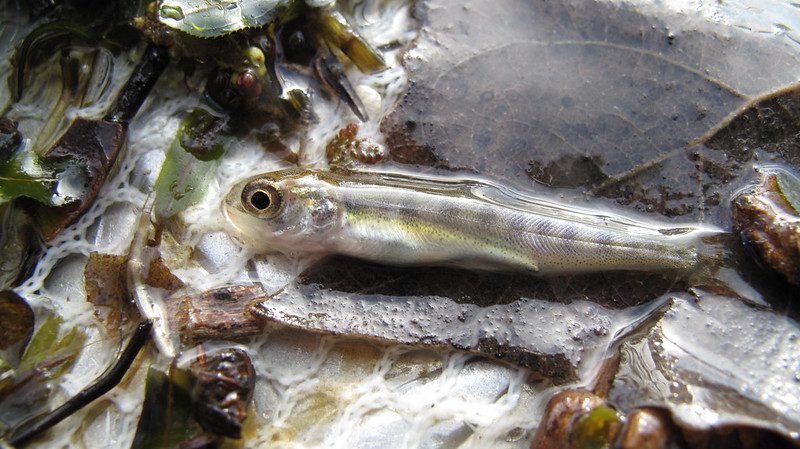Monday February 27, 2023

Thiamine (also called vitamin B1) is essential for converting food into energy in most life forms, but many animals cannot produce this compound on their own. Therefore, thiamine must be acquired through diet. Thiamine deficiency, or a lack of thiamine, occurs when a creature cannot retain or take in enough of this vitamin through its typical diet to power vital body functions. Thiamine deficiency is an emerging global issue for many species, from birds like the common eider (Somateria mollissima) to invertebrates like the blue mussel (Mytilus edulis). It has also been noted in foxes, chickens, and even in humans that do not have thiamine-enriched foods in their diets. Furthermore, thiamine deficiency has now become a widespread condition in many fish species, including Pacific salmonids (Oncorhynchus species). Due to the concerning increase in thiamine deficiency, especially in Central Valley Chinook salmon (O. tshawytscha) and steelhead (O. mykiss) that already face a myriad of threats, the 2022 American Fisheries Society (AFS) meeting in Spokane, Washington, held a special symposium focused on thiamine deficiency. The symposium gave a closer look into the scale of impact, current research, and treatment efforts associated with the condition.
Symptoms of Thiamine Deficiency Complex (TDC) in salmonids include lethargy, abnormal swimming patterns, and mortality, and these are typically noticed between hatching and first feeding, which is a critical development period for young salmonids. Research has shown that for most salmon species, eggs need a certain thiamine concentration to develop properly, and they get this vital nutrient from their mothers. Dr. Nate Mantua (symposium chair) from the Southwest Fisheries Science Center, recounted how thiamine deficiency was discovered in Chinook salmon in California. In January 2020, staff from multiple hatcheries in the state reported alarming rates of abnormal behavior and death in spring-run Chinook salmon fry. Young fish were seen swimming in corkscrew patterns and appeared to be very lethargic. Field crews checking rotary screw traps downstream of the wild Chinook spawning habitat also reported unusually high fry mortality in early 2020. Staff from the California Department of Fish and Wildlife (CDFW) Fish Health Lab ruled out common bacterial and viral infections by running diagnostic exams on deceased fish. The U.S. Fish and Wildlife Service then tested a hunch that low thiamine levels were responsible for early death and illness. Biologists bathed the affected fry in a thiamine bath for four hours. The health of the fry improved significantly overnight, confirming thiamine deficiency was the root cause behind the mortalities.

Diagnosing the ailment was just the start. Dr. Mantua described how an interdisciplinary team of researchers was quickly assembled to test for the deficiency, identify the cause of it, develop treatments, and assess the impacts on California salmon populations. Currently, eggs are being collected from eight hatcheries in California and sent to a lab studying TDC at the State University of New York Brockport to determine thiamine concentrations. A large portion of winter-run Chinook eggs collected in 2020, 2021, and 2022 were found to have critically low thiamine levels. And in 2022, nearly all Chinook salmon eggs tested showed low thiamine levels. Winter-run steelhead eggs from the American, Mad, and Russian rivers also had notably low thiamine levels. The question then became, why were salmon and steelhead mothers not getting enough thiamine in their diet to provide this nutrient for their eggs? To investigate the cause of TDC in young salmon, CDFW scientists worked with the fishing community to collect diet data of adult salmon captured in the ocean over the summer. In 2020, salmon were almost exclusively eating northern anchovy (Engraulis mordax), which contain high amounts of thiaminase, an enzyme that breaks down thiamine. Surveys of all the prey species along the coast, performed by NOAA Marine Fisheries Service (NMFS) showed a rapid northward expansion of anchovy and a decline of other prey species, suggesting salmon diets were changing because the prey available to them was changing.
Luckily, thiamine deficiency can be treated quite easily. Dr. Kevin Kwak, from CDFW Fish Health Lab, described treatments to reverse the deficiency. Returning salmon mothers can get a prenatal thiamine injection, and in hatcheries, eggs or fry can be soaked in thiamine baths. Dr. Kwak demonstrated that it was possible to expose eggs to a high concentration of thiamine as part of the typical hatchery spawning stepsUnfortunately, none of these treatment options can fix the root cause, the change in food available in the ocean.
The speed at which this issue was identified and addressed with steps to mitigate represents a success story for how scientific knowledge can be relayed and acted on by researchers around the globe. However, the fact that thiamine deficiency is affecting such a wide range of species speaks to much larger problems across marine ecosystems that will be very challenging to resolve.
Stay tuned for next week’s report to learn more about the impacts of thiamine deficiency in other fish species and what researchers around the world are doing to investigate the problem.
This post was featured in our weekly e-newsletter, the Fish Report. You can subscribe to the Fish Report here.
